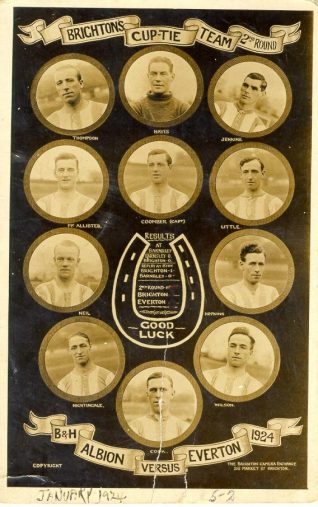A potted history

Please note that this text is an extract from a reference work written in 1990. As a result, some of the content may not reflect recent research, changes and events.
a) HISTORY: The first professional football team in the area was Brighton United, a Southern League team which played at the County Ground from 1898 until 1900 but was forced to disband towards the end of its second season owing to financial difficulties. An amateur team including some former United players, Brighton and Hove Rangers, was formed in 1900 and played on the site of Surrenden Field at Home Farm, Withdean. It was successful enough to be elected to the Southern League’s Second Division, but it too collapsed in the spring of 1901.
The former manager of Brighton United, John Jackson, determined to continue the progress that had been made and called a public meeting at the Seven Stars public house (now the Helsinki) in Ship Street on 24 June 1901 at which the present Brighton & Hove Albion club was formed (although it was briefly known as Brighton & Hove United).
Matches were played at the County Ground in 1901-2, but they moved to the Goldstone Ground for the following season and won promotion to the first division. The ‘Albion’ then struggled somewhat, but in 1909-10 they won the Southern League championship, and, on 5 September 1910, defeated Football League champions Aston Villa 1-0 at Stamford Bridge to win the F.A. Charity Shield and be dubbed ‘Champions of All England’.
The club closed down from 1915 until 1919 but became founder members of the Football League Third Division (South) in 1920. Although consistently in the upper half of the table, the Albion’s chief successes during the 1920s and 1930s were in the F.A. Cup where there were a number of giant-killing successes, notably on 2 February 1924 when Everton were beaten 5-2 and in 1932-3 when they progressed from the first qualifying round (because of a forgotten application) to the fifth round proper, a total of eleven matches. During the Second World War Albion competed in the Football League (South), Regional League (South) and London War League. The Football League recommenced in 1946, but in 1948 Albion were forced to apply for re-election for the only time.
After several near misses in the 1950s, promotion to the second division finally came in 1958. Five years later, however, the club found itself in the fourth division. The championship was won in 1965, and in 1972 the second division was regained but this success was short lived. In 1977 promotion to the second division was achieved for the third time, and, on 5 May 1979, an historic victory at Newcastle ensured promotion to the first division, a status that was maintained for four years. Although the team was relegated in 1983, the greatest day in the club’s history came on 21 May 1983 when they drew 2-2 with Manchester United in the F.A. Cup final at Wembley, watched by 100,000 spectators and an estimated 600 million people on television worldwide. The replay was lost 0-4, and the club has since had to rise once again from the third division.
The Goldstone Ground itself dates from 7 September 1901 when it was first used by Hove F.C.; the field was previously part of Goldstone Farm. The Albion first played there on 22 February 1902, and it became their permanent home the following season. The West Stand dates from 1958, although the southern section was added a little later. The North Stand was built in 1984, and the South Stand dates from 1954; it became all-seated in 1980. The ground’s floodlights were inaugurated on 10 April 1961. {123}
Any numerical cross-references in the text above refer to resources in the Sources and Bibliography section of the Encyclopaedia of Brighton by Tim Carder.
The following resource(s) is quoted as a general source for the information above: {123,124,214,215,312}




Comments about this page
I have supported Brighton and Hove Albion over the years and I believe they are now on the verge of a fabulous new era with their fabulous new stadium. They have a history of ups and downs but have always maintained a good fan-base. I started going in 1967 and haven’t followed them for some years but saw them through to the F.A. Cup final of 1983 and their 4 years in the old 1st Division. One of my favourite personal stories about the Albion is that when I lived at 48 Colbourne Avenue in Moulsecoomb from 1959-67, there was an elderly gentleman who lived 2 doors away. His name was Mr Edward Elliott and he had lived there with his wife and family for about 30 years. One day he showed me a photograph of the 1910 Brighton and Hove Albion team with the Charity Shield that they had won that year and asked if I could spot him. He said he wasn’t in the team that won but was in the squad of players that year that had won the Southern League. They were a really nice family and I used to play out in the garden with his grandchildren. I am always amazed by the fact that I have actually spoken to someone who played in the 1910 team, I wish I had been old enough to ask him more questions but at that age it doesn’t cross your mind, does it? This was 4 years before the First World War so I sometimes look at that picture and think about what those players and their families were about to go through. This is a link to a picture of that squad of players in 1910 from the James Gray Collection. http://regencysociety-jamesgray.com/volume16/source/jg_16_082.html
Add a comment about this page